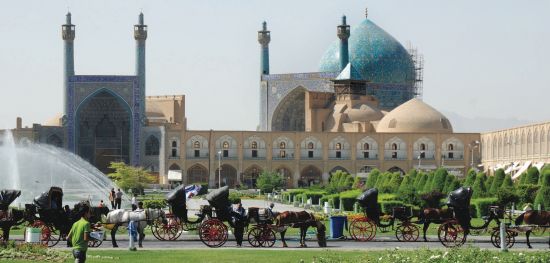Isfahan
Iran Isfahan
Achaemenid, Seljuk, Ilkhanid, Safavid, Qajar
This city, located in the middle of lran, served as the capital of the Seljuks during several historical periods. As it is situated at a point which controls the entire territory of Iran, it became a strategically significant city. it is set in an oasis on the banks of the Zayandeh River, at edge of the Great Kavir desert, south of Kum, on the slopes of the Zagros Mountains.
Ptolemy called Isfahan by the name of ''Aspadana; which means "the meeting place of the army". This term reflects the strategic location of the city, even in its earliest periods.
Isfahan was historically known as Gabae or Spahan. The city began to grow during the Achaemenid Dynasty, but there are, unfortunately, few remains from this period. The first ruins of the city to have survived date from the Sasanian era (224-651), when a palace was built on Mount Garaladan to the west of the city. The city of Jey, to the name east of Shahrestan, subsequently declined in importance. The district of the Jewish neighborhood, where the Friday Mosque now stands, began to expand and develop at this time. After the Arabs came to this area, the first mosque was built in 771 during the time of the Abbasids. Walls were built around the city when it came under the domination of the Buyid Dynasty (935-1030). The fortress of Tabaraq, located in the north-east section of the city and which appears to be a separate citadel, was built at this time. Other buildings, such as the Jurijir Mosque, were alsa built during the Buyid period. in 1050, the city was conquered by the Seijuks. During the administration of Seijuk Sultan Tugrul Bey, the city served as the capital of the Seijuks. During this time many notable structures were built, including a palace and the Nizamiye Madrasa, both which have not survived. Some of the small Seijuk period settlements, such as Ardistan, Zeware, Gez and Dashti, began to develop around the city. The minarets built in the city, such as those attached to the mosques of Saraban, Sin and Ali, are some of the most beautiful, reflecting Seijuk influence in the region. Under the administration of the Seijuks, Isfahan became a more central headquarters far controlling outlying principalities. it was far this reason that the Seijuk Sultan Tugrul Bey shifted the capital from Rayy to here. However, the city tost the posmon of central importance after the period of Sultan Sanjar, as the Seijuk state declined. When the city of Sultaniye came into prominence during the period of Ilkhanids, Isfahan and its surroundings became politically insignificant.
Following the Seijuk period in the 14th century, the city became a regional center. Small settlements in the basin of the layandeh River began to develop, and some of the structures built during the Seijuk period underwent repairs. The most important tombs, such as the Piri Bakran tomb and the tomb of Sheikh Abu Abdullah Sukla, were established in the settlements around the city. The lmamzade Jafar Tomb, with its extremely rich exterior tile decoration, was built at this time. in the 14th century, several madrasas were it also built in the city, which later came under the control of the Muzafferis. in the 15h century, several sufi dervish lodges and tombs were built in the city. in addition, many of the city's buildings were completely restored. The city came into prominence in this period as a center of ceramic production.
The city, which witnessed disputes between the Timurids and the Akkoyunlu White Sheep Turkmen tribes, gained the necessary qualmes to become a capital city at the end of the 16th century. in 1598, Shah Abbas chose Isfahan as the capital of the empire. The city then began ta develop as a religious, commercial and royal center around the old square near the Mescid-i Cuma. T o the south of the square, the building known as the Shah Mosque was built. Shah Abbas built mansions, markets and bazaars in the city. A garden with water channels and broad trees, built according ta the plan known as the ''four garden" system, and the Hodja Bridge, a 33-arched bridge across the river, were alsa erected. Water was brought by a variety of channels from the river and was transported through these structures. By the 18th century, Isfahan had become a cultural center noted far its architecture, attractive murat decorations and handicrafts. However, ft tost its primacy with the collapse of the Safavids. The city later came under the control of the Qajar dynasty. When the capftal of the state was transferred from Isfahan to Tehran, the city began to decline.
Bakhtiar, A., 'The Raya/ Bazar of Isfahan," lranian Studies 7 /1-2, 1974, pp. 320-34 - Bala, M., '1sfahan," IA v,,2, 1950, pp.1068-10772.
Beaz/ey, E., "The Pigeon Towers of Isfahan," ıran 4, 1966, pp. 105-9.
Briant, P., Histoire de l'Empire Perse. De Cyrus il /JJexandre, Paris, 1996.
Bishop Mrpp. (lsabella L.Bird), Joumeys in Persia and Kurdistan, 2 volpp., Landon, 1891. Gaube, H., lranian Cities (New York, 1979), pp. 65--98.
Godard, A., '1sfahan, "Atfıar-e ıran, ıı (1937), pp. 7-176.
Godard, A., 'The Jurjir Mosque in Isfahan," Survey of Persian Art, ed. A. U. Pope and P. Ackerman, Landon and New Yari<, 1938-9, 2/1964-7, pp. 3100-3103 ScurdeHhomine, J., 'Isfahan," in E/2 iV, 1978, pp. 97-107.
Smitfı, M.B., 'The 'Manrs' of Isfahan," Atfıar-e ıran, ı (1936), pp. 317-358.


